List of soul foods and dishes
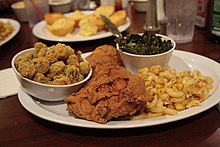
| Part of a series on |
| American cuisine |
|---|
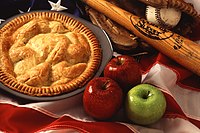 |
This is a list of soul foods and dishes. Soul food is the ethnic cuisine of African Americans that originated in the Southern United States during the era of slavery.[1] It uses a variety of ingredients and cooking styles, some of which came from West African and Central African cuisine brought over by enslaved Africans while others originated in Europe. Some are indigenous to the Americas as well, borrowed from Native American cuisine.[1][2] The foods from West-Central Africa brought to North America during the slave trade were guinea pepper, gherkin, sesame seeds, kola nuts, eggplant, watermelon, rice, cantaloupe, millet, okra, black-eyed peas, yams, and legumes such as kidney beans and lima beans. These crops became a staple in Southern cuisine in the United States.[3][4][5] Soul food dishes were created by enslaved Black Americans using minimal ingredients because slaveholders rarely fed their slaves. Historian John Blassingame's book published in 1972, The Slave Community: Plantation Life in the Antebellum South, was researched from a collection of slave narratives. According to Blassingame's research, some enslaved people received the bare minimum in food and had to supplement their diets by hunting, fishing, and foraging for food.[6][7] From their limited food sources enslaved African Americans created their meals and new dishes called soul food.[8]
Many of the meals prepared by enslaved people were later published in African-American cookbooks after the American Civil war. The dishes the enslaved and their descendants created influenced American southern cuisine.[9] An article from the Alabama News Center explains: "In recent years, culinary historians and writers have credited Africans with introducing many new cooking techniques (for example, one-pot cooking, deep-fat frying and using smoked meats as seasoning) as well as dishes to the New World. They created gumbo, an adaptation of a traditional west African stew; stewed tomatoes and okra; corn cakes, shrimp and grits; hoppin’ John, jambalaya, red rice and other rice-based dishes; collards and other greens; chow-chow and other pickled vegetables; boiled peanuts and peanut soup; and chitlins and cracklings, among other foods."[10][11]
Meat dishes
[edit]During slavery, pork was a main source of meat for enslaved Black Americans. Slaveholders only provided their slaves the parts of the pig they did not eat such as innards (chitlins), pigs' feet, pigs' ears, and pigs' tail. To supplement their diets, enslaved people hunted and fished for food.[8][12][13] Some meat soul foods and dishes include:
| Name | Image | Description |
|---|---|---|
| Buffalo ribs | 
|
A dish consisting of the breaded and deep fried ribs of the buffalo fish. Pictured is a live buffalo fish. |
| Catfish | 
|
Catfish are abundant in rivers and streams in the United States and enslaved people fished for this food and baked catfish by dredging them in cornmeal and was added with other vegetables to make a hearty meal.[14] |
| Chitlins |  |
Chitterlings (also known as chitlin's) are cleaned pig intestines; they are cooked in a pot and seasoned. The Hausa people in West Africa eat chicken intestines. Enslaved Africans in the American South continued their traditions of cooking, seasoning, and eating animal innards. Enslaved people added extremely hot peppers for additional flavor and spice to their chitlins. The parts of the pig that white plantation owners did not eat they gave to the enslaved which they used to season food and prepared one-pot meals, soups, and chitlin dishes.[15][16] |
| Crabs | 
|
After the American Civil war, African American men made up of half of watermen in the crabbing industry in the Chesapeake Bay area. They were skilled in catching fish, crabs, and oysters. African Americans living along the Atlantic coast and Gulf Coast created soul food dishes using seafood, preparing them in one-pot stews that became gumbo and other classic dishes.[17][18][19] |
| Fatback | 
|
Fatty, cured, salted pork, especially the first layers of the back of the pig primarily used in slow-cooking as a seasoning. Pictured is breaded and fried fatback. |
| Fried chicken | 
|
A dish consisting of chicken pieces usually from broiler chickens that have been floured or battered and then pan-fried, deep fried, or pressure fried. The seasoned breading adds a crisp coating or crust to the exterior.
Chicken and waffles, in particular, is a soul food dish associated with special occasions.[20] |
| Fried fish[1] | 
|
Any of several varieties of fish, including catfish, whiting,[21] porgies, bluegill, sometimes battered in seasoned cornmeal. Adapted from method of frying chicken. |
| Guinea fowl | 
|
A bird indigenous to Africa and was brought to the Americas by way of the trans-Atlantic slave trade. Guinea fowl became a source of meat for enslaved and free African Americans and eventually part of the subsistence culture of the whole region. On American plantations, the enslaved consumed the eggs of the guinea fowl, as well as cooking the meat with rice like their West-Central African ancestors.[22][23] |
| Gumbo |  |
Louisiana gumbo has influences from West African, French, Spanish, and Native American cuisines.[24] Gumbo in Louisiana has a roux for thickening and as a sauce. Gullah "gumbo" in the sea islands of South Carolina and Georgia is a tomato base.[25] In the records of slave narratives, slaves made gumbo as a meal. One slave narrative had a recipe for gumbo made by a former slave. The recipe included peppers, onions, rice, chicken and shrimp meat.[26] |
| Ham hocks [27][28] | 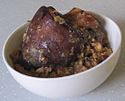
|
Typically smoked or boiled, ham hocks generally consist of much skin, tendons and ligaments, and require long cooking through stewing, smoking or braising to be made palatable. The cut of meat can be cooked with greens and other vegetables or in flavorful sauces. |
| Hog jowl | 
|
Cured and smoked cheeks of pork. It is not actually a form of bacon, but is associated with the cut due to the streaky nature of the meat and the similar flavor. Hog jowl is a staple of soul food,[29] but is also used outside the United States, for example in the Italian dish guanciale.[30][31] |
| Hog maw | 
|
The stomach lining of a pig; it is very muscular and contains no fat. As a soul food dish, hog maw has often been coupled with chitterlings, which are pig intestines. In the book Plantation Row Slave Cabin Cooking: The Roots of Soul Food hog maw is used in the Hog Maw Salad recipe.[32] |
| Jambalaya | 
|
In the records of slave narratives, formerly enslaved people from Louisiana made jambalaya as a meal with rice, pork or chicken, red pepper, onion, lard, salt and pepper.[33] |
| Oxtail[1] | 
|
The tail of cattle, oxtail is a bony, gelatin-rich meat, which is usually slow-cooked as a stew[34] or braised. |
| Oysters |  |
Enslaved and free Black Americans living near the Atlantic Ocean caught oysters for food and prepared soul food meals from this food.[19] During slavery, Thomas Downing was a free black man who lived in New York and was known as the "New York Oyster King." By 1825 he opened an oyster cellar, "Downing's Oyster House", on Broadway Street, in the city's business district. There he served raw, fried, and stewed oysters, oyster pie, fish with oyster sauce, and poached turkey stuffed with oysters.[35][36] |
| Pickled pigs' feet[27] | 
|
Slow cooked, sometimes pickled or often eaten with a vinegar based sauce. |
| Pigs' feet | 
|
Pigs' feet in soul food is a European influence as they are eaten in Europe. African Americans use pigs' feet to season their vegetables. Also during slavery, some white plantation owners gave the parts of the pig they did not eat to their slaves.[37][38] The feet of pigs: the cuts are used in various dishes around the world, and their usage increased in popularity during the Great Recession.[39] |
| Pork | 
|
As a meat dish, such as ham and bacon, and for the flavoring of vegetables and legumes, gravies and sauces. Slaveholders did not provide enough food to feed their slaves and only gave enslaved people a daily diet of pork, cornmeal, and molasses. From their limited food sources, slaves seasoned their vegetables and other food using pork fat (lard) and pork meat. This became a food tradition after emancipation in Black families to season vegetables and stews with pork meat.[8] |
| Pork ribs | 
|
The ribcage of a domestic pig, meat and bones together, is cut into usable pieces, prepared by smoking, grilling, or baking – usually with a sauce, often barbecue – and then served. The method of barbecuing is of Native American and West African influence. The Hausa word for barbecue is babbake.[40] West Africans brought their methods of barbecue and making barbecue sauce to North America. African Americans use Native American and West African techniques of barbecue.[41][42][43] |
| Poultry | 
|
Giblets, such as chicken liver and gizzards.[27][28] Pictured is a chicken gizzard dish. |
| Shit on a Shingle |  |
Chipped beef with a bechamel sauce, served on toast. Additional toppings, gravy, or beef stock may also be added. |
| Shrimp and grits |  |
Shrimp and grits is a seafood dish that was prepared by African Americans living near water sources such as the sea islands of South Carolina and Georgia and in Louisiana. This dish has become a common Southern dish prepared and eaten in different areas in the South.[44] |
| Turkey | 
|
Black Americans flavor their vegetables, collard and turnip greens using turkey necks. Turkey necks are placed in a pot of boiling water with greens and the fat from the meat adds flavor and seasoning to vegetables.[12] |
Vegetables, legumes, seeds and fruits
[edit]
Beans, greens and other vegetables are often cooked with ham or pork parts to add flavor. To supplement their diets, enslaved African Americans grew vegetables and fruits in their gardens to make one-pot stews and "gumbos."[45][46] Since the late 20th-century and into the 21st-century, some African Americans create vegan soul food meals.[47] Several Black chefs have opened vegan soul food restaurants to cook healthier foods rooted in African American culture.[48][49] Researchers at the University of Guelph noted the importance of leafy greens in African-American cuisine: "Leafy greens, both indigenous to Africa and those used in African-American cuisine, are highly nutritious, rich in calcium, copper, magnesium, manganese, potassium, zinc, iron, folic acid and vitamins A, C, B1, B2, B5, B6, and E, and are useful in promoting brain function, immune system health, and hormone production."[50]
| Name | Image | Description |
|---|---|---|
| Apples | 
|
Apples were introduced into North America by European colonists. Enslaved people made use of apples; they were battered and deep fried in oil. Apples and other fruits were dried and saved for later until consumption.[51] |
| Bell peppers | 
|
Bell peppers were grown in the gardens of enslaved people and were added to dishes to add flavor to food.[52] |
| Black-eyed peas | 
|
Black-eyed peas are native to Africa.[53] Often mixed into Hoppin' John or as a side dish.[1] Pictured are black-eyed peas with smoked hocks and corn bread. |
| Cantaloupe | 
|
A variety of cantaloupe in Africa came to North America by way of the slave trade. African Americans grew cantaloupes in their gardens.[54] |
| Cayenne pepper |  |
Cayenne peppers are native to the Americas. Enslaved and free people used cayenne peppers to make a homemade barbecue sauce and was used to add heat and flavor to other dishes.[55] |
| Collard greens | 
|
A staple vegetable of Southern U.S. cuisine, they are often prepared with other similar green leaf vegetables, such as kale, turnip greens, spinach, and mustard greens in "mixed greens".[56] They are generally eaten year-round in the South, often with a pickled pepper vinegar sauce. Typical seasonings when cooking collards can consist of smoked and salted meats (ham hocks, smoked turkey drumsticks, pork neckbones, fatback or other fatty meat), diced onions and seasonings. Historians at Cornell University noted the importance of collard greens in African-American cuisine: "Collards were among several leafy green vegetables enslaved people grew in their own gardens, enabling them to carry on a West African tradition of incorporating leafy greens into soups and stews."[57] |
| Corn |  |
During slavery, corn was part of enslaved African Americans diet. Slaveholders provided cornmeal to their slaves to make meals. It was used by enslaved people to make corn bread, hominy, and boiled corn.[58] African Americans learned from Indigenous people/Native Americans how to make ash cake, "hoe cakes", and porridge from corn.[59] During slavery and after emancipation, African Americans used cornmeal to dredge their meats and fish and was used to bake their food.[60] |
| Cornmeal | 
|
"Cornmeal was the most prevalent foods available to slaves." A former slave named Callie Elder from Georgia said her grandfather cooked catfish with lard, salt, and pepper, and rolled the catfish in cornmeal before baking. The enslaved covered their meats with cornmeal before they were fried or baked.[61] Frederick Douglass mentioned in his autobiography the rations of food enslaved men and women received in Maryland's Eastern shore: "The men and women slaves received, as their monthly allowance of food, eight pounds of pork, or its equivalent in fish, and one bushel of corn meal".[62] |
| Cucumber | 
|
Enslaved people grew cucumbers in their gardens to supplement their diets.[46] Cucumbers are used in soul food to make a cucumber relish.[63] |
| Eggplant |  |
A species of eggplant was cultivated in Africa and brought to North America by way of the slave trade. President Thomas Jefferson grew them in his garden at Monticello.[64] In soul food they are sliced, seasoned and placed in flour and hot oil for cooking; they are also an ingredient when making fritters.[65] |
| Fish peppers |  |
Enslaved and free African Americans in the Chesapeake Bay area and in Baltimore, Maryland grew fish peppers in their gardens to add flavor and heat to their seafood dishes. Food historian Michael Twitty suggests fish peppers were brought to the United States from Haiti.[66][67][68] |
| Garlic | 
|
Garlic was grown in enslaved people's gardens to add flavor to soups, stews, and meats.[69][52] |
| Gherkin | 
|
Gherkin is a species of cucumber native to Africa that was brought to North America by way of the slave trade.[70] Enslaved African Americans grew them in their gardens on the plantation of President Thomas Jefferson at Monticello in Virginia.[46] They are used in soul food cuisine to make a pickled relish.[71] |
| Guinea pepper |  |
In 1748, Peter Kalm, a Swedish-Finnish botanist, noted enslaved Africans in Philadelphia cultivated guinea peppers, a hot pepper native to West Africa. The pods of the pepper were pounded and "mixed with salt preserved in a bottle" to make sauces poured over fish and meats.[72] |
| Herbs | 
|
During slavery and after emancipation, African Americans grew herbs in their gardens to add flavor to food and for herbal medicine also called folk healing.[73] The herbs and flowers grown were basil, calendula, rosemary, thyme, parsley, sage, oregano, borage, lemon balm, hops, chamomile, and other herbs.[52] Slaves seasoned beans with one table spoon of mixed herbs, minced garlic, salt, pepper, fried bacon, onion, and hot sauce.[69] |
| Hoppin' John[74] | 
|
A dish that originated in Gullah communities in the Low country region of South Carolina, but is now popular in many areas of the south,[75] consisting of black-eyed peas (or field peas) and rice, with chopped onion and sliced bacon, seasoned with a bit of salt.[76] Some people substitute ham hock, fatback, or country sausage for the conventional bacon; a few use green peppers or vinegar and spices. |
| Irish Potato |  |
Enslaved people in Virginia grew Irish potatoes in their gardens to make one-pot stews.[77] In the records of slave narratives, a former slave named Millie Evans from Arkansas made an Irish potato pie.[78] |
| Kola nut |  |
The kola nut was brought from West Africa to North America by way of the slave trade.[79] Africans used it in their Orisha religious practices. Kola nuts were used to make Coca-Cola a carbonated soft drink.[80] |
| Lima beans |  |
Lima beans are native to Central America.[81] Portuguese explorers introduced lima beans into the African continent.[82] Enslaved people in Virginia grew lima beans in their gardens to make one-pot stews.[83] Today lima beans are enjoyed eaten as a dish in one-pot stews. To flavor them, bacon and chicken broth is added in a pot when cooking.[84] |
| Mustard greens | 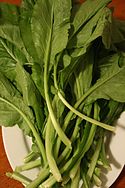
|
A species of mustard plant. Subvarieties include southern giant curled mustard, which resembles a headless cabbage such as kale, but with a distinct horseradish-mustard flavor. It is also known as green mustard cabbage. |
| Okra[85] | 
|
A vegetable that is native to West Africa and is eaten fried or stewed and is a traditional ingredient of gumbo. It is sometimes cooked with tomatoes, corn, onions and hot peppers. In West Africa and in African-American cuisine, okra is used to thicken stews and soups.[86] In Gullah communities, cooked okra soup is prepared with "...tomatoes, and smoked meat served over rice."[87] |
| Fried okra | 
|
Okra pods that have been sliced and dredged in cornmeal before frying. |
| Onion | 
|
Onions were grown in the gardens of enslaved people to add flavor to soup, stews, and meats. Onions were added with garlic and peppers in a skillet to add additional flavor to food.[69][88] |
| Peach | 
|
Peaches were introduced into North America by European colonists. African American slaves stewed peaches and made peach pies and brandy. Peaches and other fruits were dried and saved for later until consumption.[89] |
| Peanuts | 
|
West Africans mixed the Bambara groundnut with yams, cereal, flour, African palm oil, and melegueta pepper. Portuguese explorers introduced the American peanut from Brazil into the African continent. Africans grew peanuts in their gardens and made soups and stews with this food. Peanuts were also used as food on slave ships to feed enslaved captives. Enslaved Africans in the Southern United States prepared meals using peanuts similar to how they used the African Bambara groundnut. Slaveholders considered the peanut "slave food," and was the reason white plantation owners did not eat peanut dishes prepared by their slaves.[90] Peanuts were grown in the gardens of enslaved people and were made into soups, stews, and peanut butter.[52][91] |
| Persimmons | 
|
Enslaved African Americans made recipes with persimmons. Persimmons grew wild in the South and were available during autumn (fall) season, and slaves harvested them by shaking persimmon trees or gathering them off the ground. Some slaves grew persimmons. They were made into pies, drinks (beer), combined with cornmeal, and added to other foods to make a meal.[92] |
| Sea Island red peas |  |
Sea Island red peas are a variety of cowpea from West Africa brought to the sea islands of South Carolina during the slave trade. They are used in Gullah rice and bean dishes.[93] |
| Sesame seeds |  |
Sesame seeds are native to West Africa and were brought to South Carolina in 1730 by way of the slave trade. Enslaved and free Black people used sesame seeds to make sesame pudding, prepared stews, baked breads, and boiled their greens with sesame seeds. Slaves ate sesame raw, toasted, and boiled. It was used as an ingredient for baked breads in colonial America and is still used in the present day.[94] |
| Squash | 
|
Squash is native to Central America and are also called sweet potato pumpkin. It was grown in the gardens of enslaved Black Americans in Virginia. President Thomas Jefferson recorded in his journal the vegetables his slaves grew. Jefferson noted: "On account of the extreme resemblance of its taste to that of the sweet potato, it may be originating form your islands…it is well esteemed at our tables, and particularly valued by our Negroes." As enslaved people moved to the Appalachian Mountains they brought the seeds of squash with them and influenced Appalachian cuisine.[95] |
| Sweet potatoes | 
|
Often parboiled, sliced, then adorned with butter, sugar, cinnamon, nutmeg, vanilla or other spices, and baked; commonly called "candied sweets" or "candied yams"[27] |
| Tomato |  |
Tomatoes are native to the Americas. Free and enslaved African Americans grew tomatoes in their gardens to make one-pot stews and gumbo.[96] Former slave Clara Davis from Alabama cooked catfish using tomatoes and potatoes or prepared baked catfish with a tomato gravy and sweet potatoes.[97] |
| Turnip greens | 
|
Turnip leaves are sometimes eaten as "turnip greens", and they resemble mustard greens in flavor. Turnip greens are a common side dish in southeastern US cooking, primarily during late fall and winter. Smaller leaves are preferred; however, any bitter taste of larger leaves can be reduced by pouring off the water from initial boiling and replacing it with fresh water. Varieties specifically grown for the leaves resemble mustard greens more than those grown for the roots, with small or no storage roots. |
| Watermelon |  |
Watermelon came from Africa to North America by way of the slave trade. Enslaved African Americans grew them in their gardens for food. Due to their red color, they are eaten during Juneteenth celebrations. The color red represents resilience and joy.[98][99] |
Breads and grains
[edit]Rice was a cash crop in the South Carolina Lowcountry, and during the slave trade, Europeans selected coastal inhabitants of West Africa who had knowledge of rice cultivation.[100][101] Other grains such as millet and sorghum were cultivated in Africa and were used in West-Central African cooking to make stews.[102]
| Name | Image | Description |
|---|---|---|
| Charleston red rice | 
|
Charleston red rice is made with rice and tomato paste. The dish was created in the Gullah Geechee community. Charleston red rice originated from jollof rice in West Africa, which is made with a tomato product giving the rice its red color.[103] |
| Cornbread[104] | 
|
A quickbread often baked or made in a skillet, commonly made with buttermilk and seasoned with bacon fat; inspired by the great availability of corn in America. Cornbread is of Native American origin. Traditional southern cornbread is baked in European cake and bread baking style. Pictured is skillet cornbread. |
| Dirty rice | 
|
Dirty rice is a dish from Louisiana. The name is from rice cooked with poultry, beef or pork and with green bell pepper, celery, and onions.[105] |
| Grits[106] | 
|
A cooked coarsely ground cornmeal of Native American origin. |
| Hoecake[1] | 
|
Also known as Johnnycake, a type of cornbread that is thin in texture, and fried in cooking oil in a skillet, whose name is derived from field hands' often cooking it on a shovel or hoe held to an open flame. |
| Hushpuppies[1] | 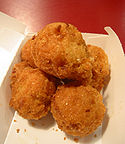
|
Balls of deep-fried cornmeal, usually with salt and diced onions. Typical hushpuppy ingredients include cornmeal, wheat flour, eggs, salt, baking soda, milk or buttermilk, and water, and may include onion, spring onion (scallion), garlic, whole kernel corn, and peppers. |
| Millet | 
|
Millet is a grain grown in West Africa and was brought to North America by way of the slave trade. Millet is used in soul food to thicken soups and stews. Igbo people in West Africa cooked millet in a pot with vegetables, meats, poultry, and fish. In Central Africa, Congolese people cooked millet with palm oil. This method of cooking grains with meats in one-pot stews from West-Central Africa continued in the Southern United States in the slave community and after Emancipation in African-American communities. They combined North American ingredients and African crops and created dishes that became gumbo and other classic southern foods.[102] |
| Rice | 
|
A species of rice was domesticated in Africa, so many people brought to the Americas during the slave trade preserved rice cooking techniques from West Africa. Rice is a staple side dish in the lowcountry region and in Louisiana. It is a main ingredient in dishes such as jambalaya and red beans and rice popular in Southern Louisiana.[107][53] |
| Red beans and rice | 
|
Red beans and rice is a dish from Louisiana. It is made with kidney beans, bell pepper, onion, and celery and with spices and meats such as ham and sausage.[108] |
| Sorghum | 
|
A species of sorghum was cultivated in Africa and was brought to North America by way of the slave trade. Enslaved and free African Americans used sorghum to make sorghum molasses.[109] |
Desserts
[edit]| Name | Image | Description |
|---|---|---|
| Sweet potato pie[1][21] | 
|
Parboiled sweet potatoes, then pureed, spiced, and baked in a pie crust, similar in texture to pumpkin pie. A traditional dessert in African American families during Thanksgiving and Christmas holidays is making and eating sweet potato pie.[110] In the records of slave narratives, enslaved people made sweet potato pie.[111] |
| Banana pudding[112] | 
|
Pudding made with vanilla custard, vanilla wafers, bananas, whipped cream and vanilla extract |
| Red velvet cake[113] | 
|
Red colored cake made with cocoa powder. Red food and drinks are traditional during Juneteenth celebrations, including red velvet cake. The color red represents resilience and joy.[114][99] |
| Pecan pie[115] | 
|
Pie made with pecans |
Regional Soul Food
[edit]
These are more specific regional Soul food dishes.This includes dishes like Jambalaya, Gumbo, red rice and beans and other foods of the creole subgroup of the Black American ethnic group. It also includes the dishes of the Gullah Geeche sub group of the Black American peoples. See: Louisiana Creole cuisine and Gullah Geeche cuisine.
Chicken and waffles became a common soul food item in Black communities in Maryland and in Harlem, New York. During the blues and jazz era, musicians and singers ate at soul food restaurants located inside black-owned night clubs and cooks prepared chicken and waffles for their customers.[116][117]
See also
[edit]- List of American foods
- List of foods of the Southern United States
- Louisiana Creole cuisine
- List of American desserts
References
[edit]- ^ a b c d e f g h Opie, Frederick Douglass (2008). Hog and Hominy. Columbia University Press. p. 133. ISBN 978-0231146388. Retrieved June 29, 2009.
- ^ Ferguson 1993
- ^ Holloway, Joseph. "African Crops and Slave Cuisine". Slave Rebellion Info. Slave Rebellion Website. Retrieved 31 May 2024.
- ^ "Diet and Nutrition". Santa Clara University Digital Exhibits. Santa Clara University. Retrieved 21 June 2024.
- ^ McLaughlin, John. "A Guide to Planting an African-American/African Focused Yard in Miami-Dade County: An Overview of Landscape Design and Plants Grown in Traditional African-American Yards" (PDF). University of Florida / IFAS Extension. Retrieved 12 July 2024.
- ^ Blassingame, John (1972). The Slave Community: Plantation Life in the Antebellum South. Oxford University Press. pp. 39, 155–158. ISBN 9780195025637.
- ^ Brown, Shayla (2020). "Slavery, Soul Food and the Power of Black Women". North Jersey News. Retrieved 3 June 2024.
- ^ a b c Lumpkins, Charles. "Soul Food". Oxford African American Studies Center. Oxford University. Retrieved 11 July 2024.
- ^ Deetz, Kelly (2017). Bound to the Fire How Virginia's Enslaved Cooks Helped Invent American Cuisine. University Press of Kentucky. pp. 4, 122–123. ISBN 9780813174747.
- ^ Blalock, Bob (2019). "African-Americans have shaped Alabama's and America's cuisine". Alabama News Center. Retrieved 6 July 2024.
- ^ "Seeds of Survival and Celebration: Plants of the Black Experience" (PDF). Cornell Botanical Gardens. Retrieved 16 June 2024.
- ^ a b Thomas, Clarence (23 February 2024). "Soul food roots: West Africa in Central Georgia kitchens". Macon Magazine. Retrieved 26 May 2024.
- ^ Gattuso, Raina (14 October 2020). "A Historical Dig Sheds Light on the Food of the Underground Railroad". www.atlasobscura.com. Atlas Obscura. Retrieved 23 June 2024.
- ^ Covey, Herbert; Eisnach, Dwight (2009). What the Slaves Ate Recollections of African American Foods and Foodways from the Slave Narratives. Bloomsbury Publishing. ISBN 9798216164265.
- ^ Bower, Anne (2009). African American Foodways Explorations of History and Culture. University of Illinois Press. p. 51. ISBN 9780252076305.
- ^ Lowery, Sharelle (2014). "Chitlin's From Slave Food to Delicacy The Black American Kitchen". The Bay State Banner. Retrieved 9 June 2024.
- ^ Bower, Anne (2009). African American Foodways Explorations of History and Culture. University of Illinois Press. p. 162. ISBN 9780252076305.
- ^ Willhoite, Kenneth (2018). The Soul Food Museum Story Celebrating 400 Years of Culinary Arts Hospitality and Agriculture. Arthur House. ISBN 9781546225140.
- ^ a b "Black Foodways and Cuisine". National Museum of African American History and Culture. Smithsonian Institution. Retrieved 30 June 2024.
- ^ "Serving up chicken & waffles". Los Angeles Business Journal. September 22, 1997. p. 1.
- ^ a b Feeney, Kelly (May 8, 2009). "Soul Food With a Secret". The New York Times. Retrieved March 27, 2013.
- ^ Davis, Donald (2006). Southern United States: An Environmental History. Bloomsbury Publishing. p. 130. ISBN 9781851097852.
- ^ Carney, Judith (2013). "Seeds of Memory: Botanical Legacies of the African Diaspora" (PDF). African Ethnobotany in the Americas: 15, 20. Retrieved 6 June 2024.
- ^ "Gumbo combines African Native American French Spanish | Classic Chicago Magazine". classicchicagomagazine.com. Retrieved 2022-12-09.
- ^ Donaldson, Tara. "Gullah-Geechee Cuisine Is Finally Getting Its Due in Charleston". www.afar.com. Afar. Retrieved 7 July 2024.
- ^ Covey, Herbert; Eisnach, Dwight (2009). What the Slaves Ate Recollections of African American Foods and Foodways from the Slave Narratives. Bloomsbury Publishing. ISBN 9798216164265.
- ^ a b c d Timothy Williams In Changing Harlem, Soul Food Struggles 5, 2008 New York Times
- ^ a b Mike Royko FOOD NAGS CAN KILL ANYONE'S APPETITE July 20, 1994 Page: 3 Chicago Tribune
- ^ Gillespie, Carmen (2009). Toni Morrison: A Literary Reference to Her Life and Work. Infobase Publishing. p. 343. ISBN 9781438108575. Retrieved 28 July 2012.
- ^ Fabricant, Florence (September 13, 2011). "Pork Jowl With a Backwoods Whiff". New York Times. Retrieved July 27, 2012.
- ^ May, Tony (2005-06-01). Italian Cuisine: The New Essential Reference to the Riches of the Italian Table. Macmillan. p. 11. ISBN 9780312302801. Retrieved 28 July 2012.
- ^ "Plantation Row Slave Cabin Cooking: The Roots of Soul Food". Retrieved 2007-10-08.
- ^ "Slave Narratives of Louisianians Living in Texas" (PDF). www.mylhcv.com. Retrieved 14 July 2024.
- ^ Blumenthal, Heston (14 November 2003). "The twist in the tail". The Guardian. London. Retrieved 16 August 2012.
- ^ "Downing's Oyster House". Mapping the African American Past. Columbia University. Retrieved 20 June 2024.
- ^ Filippenko, Alexandra (26 June 2017). "Original soul food wrapped in rich history". www.museeum.com. Museeum. Retrieved 20 June 2024.
- ^ Ferguson, Sheila (1993). Soul Food Classic Cuisine from the Deep South. Grove Press. p. 51. ISBN 9780802132833.
- ^ Alan, Davidson (2006). The Oxford Companion to Food. Oxford University Press. ISBN 9780191018251.
- ^ Carmichael, Sri (21 October 2009). "Pig's trotters fly off the shelves as customers seek cheap meat cuts". The Evening Standard. Archived from the original on 24 October 2009.
- ^ Twitty, Michael (2015). "Barbecue is an American Tradition – of Enslaved Africans and Native Americans". The Guardian. Retrieved 4 June 2024.
- ^ Miller, Adrian (2021). "How the long history of black barbecue was erased". Independent. Retrieved 30 June 2024.
- ^ Miller, Adrian (2021). Black Smoke African Americans and the United States of Barbecue. University of North Carolina Press. pp. 22–25, 39–49, 50–57. ISBN 9781469662817.
- ^ Béchard, Deni. "The Bard of Barbecue". Stanford Magazine. Stanford University. Retrieved 30 June 2024.
- ^ Necole, Shaunda. "Black Folks Southern Shrimp And Grits Recipe". The Soul Food Pot. Retrieved 7 July 2024.
- ^ "Slave Gardens". www.encyclopedia.com. Encyclopedia.com. Retrieved 16 June 2024.
- ^ a b c Bates, Justin. "Planting Legacies: Gardens of Enslaved Families at Monticello". www.monticello.org. Thomas Jefferson Monticello. Retrieved 8 July 2024.
- ^ Shelf, Angela. "African Vegetarian Recipes : The Ethnic Vegetarian". Enotalone.com. Retrieved 2009-06-20.
- ^ Carter, Christopher (31 January 2022). "Is Black Veganism the Future of Soul Food". www.zocalopublicsquare.org. Zocalo Public Square. Retrieved 8 June 2024.
- ^ Crimarco, Anthony, etl. (2020). ""We're Not Meat Shamers. We're Plant Pushers.": How Owners of Local Vegan Soul Food Restaurants Promote Healthy Eating in the African American Community". Journal of Black Studies. 51 (2): 168–193. doi:10.1177/0021934719895575. JSTOR 26985178. Retrieved 1 July 2024.
{{cite journal}}: CS1 maint: multiple names: authors list (link) - ^ Sousa, Emily; Raizada, Manish (2020). "Contributions of African Crops to American Culture and Beyond: The Slave Trade and Other Journeys of Resilient Peoples and Crops". Frontiers in Sustainable Food Systems. 4. Land, Livelihoods and Food Security. doi:10.3389/fsufs.2020.586340.
- ^ Covey, Herbert; Eisnach, Dwight (2009). What the Slaves Ate Recollections of African American Foods and Foodways from the Slave Narratives. Bloomsbury Publishing. ISBN 9798216164265.
- ^ a b c d Harte, Tiffany. "Celebrate Juneteenth by Planting an 'Emancipation Garden'". Atlanta History Center. Retrieved 12 July 2024.
- ^ a b "Origins of Soul Food". Suny Schenectady County Community College. Begley Library. Retrieved 3 June 2024.
- ^ McLaughlin, John. "A Guide to Planting an African-American/African Focused Yard in Miami-Dade County: An Overview of Landscape Design and Plants Grown in Traditional African-American Yards" (PDF). University of Florida / IFAS Extension. Retrieved 12 July 2024.
- ^ Bower, Ann, etl. (2009). African American Foodways: Explorations of History and Culture. University of Illinois Press. pp. 29, 33–34. ISBN 9780252076305.
{{cite book}}: CS1 maint: multiple names: authors list (link) - ^ Diana Rattray, About.com Guide (2012-04-10). "Mixed Greens - Recipe for Greens". Southernfood.about.com. Retrieved 2012-07-26.
- ^ Kelley, Cornell. "Seeds of survival: Botanic Gardens honors the Black experience". Department of Sociology / Cornell Chronicle. Cornell University. Retrieved 11 July 2024.
- ^ "A 19th Century Slave Diet" (PDF). www.nps.gov/bowa. The National Park Service. Retrieved 24 May 2024.
- ^ "Seeds of Survival and Celebration: Plants of the Black Experience" (PDF). Cornell Botanical Gardens. Retrieved 16 June 2024.
- ^ Jackson, Sheila (1993). Soul Food Classic Cuisine from the Deep South. Grove Press. p. xxii. ISBN 9780802132833.
- ^ Covey, Herbert; Eisnach, Dwight (2009). What the Slaves Ate Recollections of African American Foods and Foodways from the Slave Narratives. Bloomsbury Publishing. ISBN 9798216164265.
- ^ Douglass, Frederick (1845). Narrative of the Life of Frederick Douglass, an American Slave. Written by Himself. THE ANTI-SLAVERY OFFICE. p. 10.
- ^ Ferguson, Sheila (1993). Soul Food: Classic Cuisine from the Deep South. Grove Press. pp. 91, 95. ISBN 9780802132833.
- ^ "Eggplant". Lost Crops of Africa: Volume II: Vegetables. 2. 2006. Retrieved 8 July 2024.
- ^ Ferguson, Sheila (1993). Soul Food:Classic Cuisine from the Deep South. Grove Press. pp. xxiii, 108. ISBN 9780802132833.
- ^ "Fish Peppers". www.chesapeakebaymagazine.com. Chesapeake Bay Magazine. 28 July 2020. Retrieved 21 June 2024.
- ^ Larson, Zeb (2024). "The US pepper that was nearly lost". BBC News. Retrieved 21 June 2024.
- ^ Intern, Waxter (28 July 2017). "Maryland Food History: The Fish Pepper". Preservation Maryland. Retrieved 21 June 2024.
- ^ a b c Covey, Herbert; Eisnach, Dwight (2009). What the Slaves Ate Recollections of African American Foods and Foodways from the Slave Narratives. Bloomsbury Publishing. ISBN 9798216164265.
- ^ "Maxixe Cucumis anguria". World Crops. Retrieved 8 July 2024.
- ^ Jackson, Sheila (1993). Soul Food Classic Cuisine from the Deep South. Grove Press. p. 92. ISBN 9780802132833.
- ^ Houck, Brenna. "Regional Barbecue Sauce Styles, Explained". Eater. Retrieved 30 June 2024.
- ^ "Mid-19th Century Plant Uses" (PDF). The National Park Service. Retrieved 4 August 2024.
- ^ "On New Year's Day, it gets the full Southern treatment, which usually means Hoppin' John – a traditional Soul Food fixin' consisting of F peas cooked with ham hocks and spices, served over rice. In the South, eating field-peas on New Year's is thought to bring prosperity" Celebrate New Year's with Field- peas by Rachel Ellner December 31, 2008 Nashua Telegraph
- ^ a b Smith Miles, Suzannah (22 December 2014). "Hoppin' John". www.charlestonmag.com. Charleston Magazine. Retrieved 20 May 2024.
- ^ Hoppin John What's cooking America.Another name for it is Stew Peas
- ^ "Mid-19th Century Plant Uses" (PDF). www.nps.gov/bowa. The National Park Service. Retrieved 24 May 2024.
- ^ Covey, Herbert; Eisnach, Dwight (2009). What the Slaves Ate Recollections of African American Foods and Foodways from the Slave Narratives. Bloomsbury Publishing. ISBN 9798216164265.
- ^ Jahannes, Naftal (2021). "Black influences have shaped American food for centuries". Savannah Morning News. Retrieved 7 July 2024.
- ^ Sprague, Kevin. "The kola nut: West African commodity in the Atlantic world". www.nhlrc.ucla.edu. UCLA university. Retrieved 7 July 2024.
- ^ "Lima Beans" (PDF). www.nj.gov. State of New Jersey. Retrieved 8 July 2024.
- ^ "Lima Beans". Nature's Produce. Retrieved 8 July 2024.
- ^ "Mid-19th Century Plant Uses" (PDF). www.nps.gov/bowa. The National Park Service. Retrieved 24 May 2024.
- ^ Mayes, Rosie (2020). I Heart Soul Food: 100 Southern Comfort Food Favorites. Sasquatch Books. p. 117. ISBN 9781632173102.
- ^ Marcus, Jacqueline B. (2013). Culinary Nutrition: The Science and Practice of Healthy Cooking. Academic Press. Page 547. ISBN 0123918839
- ^ "The Culinary Legacy of Soul Food: Shaping American Cuisine". Community Coalition. Retrieved 14 July 2024.
- ^ Schneider-Green, Emmy. "Okra's Deeply Rooted History In Southern Cuisine". Tasting Table. Retrieved 11 July 2024.
- ^ Covey, Herbert; Eisnach, Dwight (2009). What the Slaves Ate Recollections of African American Foods and Foodways from the Slave Narratives. Bloomsbury Publishing. ISBN 9798216164265.
- ^ Covey, Herbert; Eisnach, Dwight (2009). What the Slaves Ate Recollections of African American Foods and Foodways from the Slave Narratives. Bloomsbury Publishing. ISBN 9798216164265.
- ^ Carney, Judith (2011). In the Shadow of Slavery Africa's Botanical Legacy in the Atlantic World. University of California Press. pp. 69, 141–143. ISBN 9780520949539.
- ^ Opie, Frederick D. (2008). Hog and Hominy Soul Food from Africa to America. Columbia University Press. pp. 72, 94, 134–135. ISBN 9780231517973.
- ^ Covey, Herbert; Eisnach, Dwight (2009). What the Slaves Ate Recollections of African American Foods and Foodways from the Slave Narratives. Bloomsbury Publishing. ISBN 9798216164265.
- ^ Townsend, Bob (2019). "Recipes that celebrate the culinary history of the African diaspora". The Atlanta Journal-Constitution. Retrieved 16 June 2024.
- ^ Holloway, Joseph. "African Crops and Slave Cuisine". Slave Rebellion. Retrieved 7 July 2024.
- ^ Twitty, Michael. ""Slave Food" The Sweet Potato Pumpkin". The Cooking Gene. Retrieved 11 July 2024.
- ^ "Mid-19th Century Plant Uses" (PDF). www.nps.gov/bowa. The National Park Service. Retrieved 24 May 2024.
- ^ Covey, Herbert; Eisnach, Dwight (2009). What the Slaves Ate Recollections of African American Foods and Foodways from the Slave Narratives. Bloomsbury Publishing. pp. 104–105, 129, 171–172, 174. ISBN 9798216164265.
- ^ Mekouar, Dora. "How Enslaved Africans Helped Invent American Cuisine". www.voanews.com. VOA News. Retrieved 7 July 2024.
- ^ a b Amen, Sunyatta (June 10, 2022). "For Juneteenth, this hibiscus red drink is steeped in history". Washington Post. Archived from the original on July 5, 2022. Retrieved November 25, 2022.
- ^ "Rice in the Lowcountry". Lowcountry Digital History Initiative. College of Charleston. Retrieved 1 June 2024.
- ^ Carney, Judith Ann (2009-06-30). Black rice: the African origins of rice cultivation in the Americas. Cambridge, Massachusetts. ISBN 9780674029217. OCLC 657619002.
{{cite book}}: CS1 maint: location missing publisher (link) - ^ a b Opie, Frederick D. (2008). Hog and Hominy: Soul Food from Africa to America. Columbia University Press. pp. 2–10, 14–15. ISBN 9780231517973.
- ^ "Discover the History of Charleston in Three Mouthwatering Meals". Smithsonian Magazine. Smithsonian Institution. Retrieved 25 May 2024.
- ^ St. John, Warren (October 6, 2004). "Greens in Black and White". The New York Times. Retrieved March 28, 2013.
- ^ Jackson, Sheila (1993). Soul Food Classic Cuisine from the Deep South. Grove Press. p. 68. ISBN 9780802132833.
- ^ Ferguson 1993, pp. 25-26.
- ^ Jao, Carren. "A brief look at Black American history told through 10 food traditions". www.abqjournal.com. Albuquerque Journal. Retrieved 3 June 2024.
- ^ Edge, John T., ed. (2014). "Red Beans and Rice". The New Encyclopedia of Southern Culture: Volume 7: Foodways. pp. 243–4. ISBN 978-1-4696-1652-0.
- ^ Ferguson, Sheila (1993). Soul Food: Classic Cuisine from the Deep South. Grove Press. p. xxv. ISBN 9780802132833.
- ^ "Seeds of Survival and Celebration: Plants of the Black Experience" (PDF). Cornell Botanical Gardens. Retrieved 16 June 2024.
- ^ Covey, Herbert; Eisnach, Dwight (2009). What the Slaves Ate Recollections of African American Foods and Foodways from the Slave Narratives. Bloomsbury Publishing. ISBN 9798216164265.
- ^ 7 Soul Food Dessert Recipes You Have To Try
- ^ Dessert
- ^ Ayele Djossa, Christina (19 June 2018). "The Story Behind Red-Hued Juneteenth Food and Drink". www.atlasobscura.com. The Atlanta Obscure. Retrieved 1 June 2024.
- ^ "Soul Food Dessert Recipes - Taste Like Grandma's".
- ^ Opie, Frederick (2008). Hog and Hominy: Soul Food from Africa to America. Columbia University Press. ISBN 9780231146395.
- ^ Thomas, Amelia. "A Harlem soul food fix". www.bbc.com. BBC. Retrieved 9 June 2024.
Bibliography
[edit]- Ferguson, Sheila (1993). Soul Food: Classic Cuisine from the Deep South. Grove Press. ISBN 0802132839
Further reading
[edit]- Woods, Sylvia (1992). Sylvia's Soul Food. HarperCollins. ISBN 0688100120
